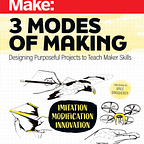Transformational Journeys in the Makerspace; Part 1
Today was the beginning of the Human Geography project in the BITlab. You can read more about the project in my intro to this week of reflections, but in essence students need to create an object that demonstrates the growth and transformation of the main character of one of three books, The Boy Who Harnessed the Wind, The Kabul Girls Soccer Club or Outrun the Moon. Today I met with six classes (including 2 at once!) and gave them an intro to some of the tools they would have access to and some of the considerations they would need to think through as they used their three classes in the BITlab. I had created these three Info Sheets that they can refer to so that they don’t need to wait on me for trivial things like where to go to find 3D models.
We also use Google Drive file stream as a way for students to share files easily from their computers to computers that are connected to 3D printers or the laser cutter. Google Drive file stream is a system that puts files from Google Drive onto your computer in a folder system set up like your Google Drive. For this project I created a folder in our BITlab Google account and shared that out with each group. They can save their 3D files and Vector files into this folder and I can easily open it up on whichever control computer is needed. This saves time on emailing files to the BITlab account and makes it easy for me to keep track of what the groups have created (or if they haven’t created anything!). Another nice feature is that all the students need to know is to get their files in that folder, the rest takes care of itself.
After going over the file stream and the info sheets as quickly as possible, groups got to work solidifying their ideas. It’s pretty clear that some work will need to happen outside of class at home, after school or during study hall; but if time in the BITlab is focused on working on the parts that they need assistance or to be together as a group, they should be able to get everything they need created for the final project. Some groups were ready to go, and others needed a little help thinking up ideas, so I moved from group to group to offer consultation and listen to their ideas.
It’s Not Just a Windmill
The most important aspect of this project is that the object they create has to do some pretty heavy lifting. With a minimum of accompanying text, the object needs to describe the groups interpretation of the main characters growth and transformation. In one of the books, the central object is a windmill. There were several groups who came in with the idea of making a windmill. By the end of the day I had baked it into my intro that were weren’t just making windmills in the BITlab, we were making windmills that tell a story. I equated it to the difference between a book report and an essay. A book report is a literal representation of the words in the book, and essay seeks to interpret what happened in the book. One is a recounting, the other is a reframing. By the end of each block all of the groups had quickly shifted the more literal ideas into symbolic or metaphoric ideas. Windmills are becoming more than windmills; they are becoming symbols of hope, accomplishment, perseverance, etc.
It is also the case that not all windmills are created equal. If you go to Thingiverse and look up 3D models of windmills, you will find some very nice dutch windmills. In my opinion it would be a bad idea to use one of these windmills when talking about a windmill that looked like this. In this case it is going to be necessary to design your own version of this, build it out of your own scraps, or abstract the windmill to a degree that it doesn’t matter much how it looks. This also goes for soccer stadiums and catholic schools, which were popular images from the other books.
Variety Is the Spice of the Makerspace
So far, despite these repeated themes and images, no two groups have come up with something exactly alike. Some have similar elements, but the range of responses has been impressive. I have seen concepts for 3D timelines, hot air balloons, boxes of chocolates, board games, pop up books, moving gears and many more. Each of these projects will take a lot of creative and critical thinking, a lot of work, and will ultimately have to stand on its own as a representation of a pretty deep concept. I am excited to see them take shape!
